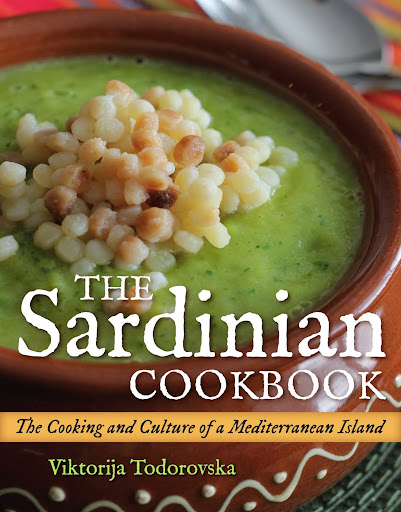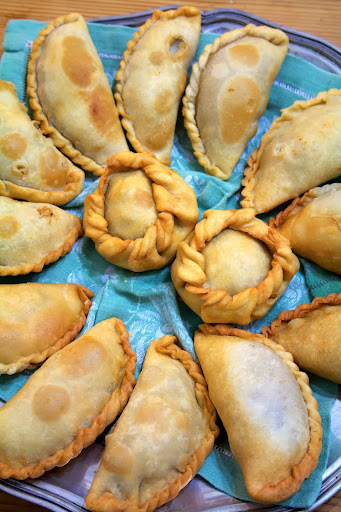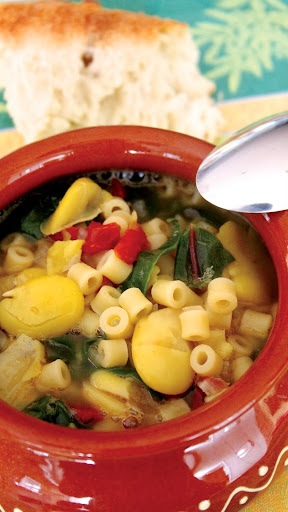The Sardinian Cookbook: The Cooking and Culture of a Mediterranean Island
Americans have been hooked on pizza and pasta since Italian immigrants began dishing it out decades ago. That’s where many of us got our perception of Italian food. Now, with the popularity of travel abroad, that perception is changing.
In The Sardinian Cookbook: The Cooking and Culture of a Mediterranean Island, Viktorija Todorovska breaks the Italian food mold. Through more than 100 recipes, the chef, author, teacher, and sommelier invites readers to savor Sardinia’s ancient history and culture through its unique cuisine.

Ever heard of Lasagna with Tuna and Pesto? How about Minestrone soup with Fava Beans? Maybe you’d love some Spaghetti with Bottarga? In this 271-page cookbook, these are just three of the recipes that challenge our taste buds and stereotypes of Italian food.
Sardinia reflects a rich blend of Spanish, Moorish, French, and Italian traditions and cultures that have all contributed to its identity, character, and unheralded cuisine. This is a cookbook filled with easy-to-prepare recipes, some of which consist of four ingredients and require no cooking.

Mullet Bottarga
“I teach cooking to home cooks, so my purpose is always to make things uncomplicated,” said Todorovska, a native of Macedonia who fell in love with Italy while studying Italian cooking at Apicius International School of Hospitality in Florence.
As in her first cookbook, The Puglian Cookbook: Bringing the Flavors of Puglia Home published in April 2011 by Surrey Books, in this cookbook Todorovska teaches readers the origins of ingredients used in the recipes.
For example, salted and dried fish roe called bottarga is “Sardinia caviar,” a delicacy found in coastal areas. Other staple Sardinian ingredients include saffron, honey, and sun-dried tomatoes. The versatile pane carasau, also known as carta da musica (music-sheet bread) is found on every table.

Pane Carasau
The Sardinian Cookbook is a fascinating journey through a majestic island off the coast of Italy. Colorful photographs of the scenic, natural beauty are combined with photos of traditional recipes to enhance understanding of this unparalleled cuisine.
Tourists are drawn to its 1,800 kilometers of coastline with white, sandy beaches and turquoise waters. It’s no wonder royalty, celebrities, and the wealthy frequent Sardinia. But a hike inland reveals a different world.
Here in the forests and mountains is the essence of Sardinia. Shepherds, sheep, goats, and a rustic lifestyle await anyone willing to venture beyond the coastline. Once inland, visitors indulge on a delectable cuisine created with seemingly unusual ingredients.
Take fregola, one of Sardinia’s most unique pastas, which doubles as an ingredient and a stand-alone pasta dish. Semolina-based, fregola adorns the zucchini soup featured on the cover of this exquisite new cookbook.
“Sardinia has some of the most varied and interesting types of pasta. A few of the pasta shapes are unique to the island and have a long history. The two most typical shapes are malloreddus, also known as gnoccheti sardi, and fregola. Fregola is best described as a cross between pasta and couscous,” she writes.
Who didn’t grow up with mozzarella sprinkled on pizza and other Italian-American dishes? But the use of pecorino sardo, pecorino romano, and fiore sardo may be unknown to Italian food lovers here. One reason is that these three venerated Sardinian cheeses are made from sheep’s milk.
In fact, they are so highly prized that they have obtained their own Denominazione de Origine (DO) in Sardinia. This means they are recognized by the Italian government and European Union as singularly unique products tied to traditions and place.
The DO distinction is similar to that awarded to wines, which is another distinguishing feature of the Sardinian Cookbook. Todorovska includes suggestions on which Sardinian red or white wine pairs well with a particular dish.
Many of the grapes grown on the island were in all likelihood brought by the Spanish. The most famous grapes are the red grape Cannonau, known as Grenache outside of Italy, and Vermentino grapes used to produce white wines.
“All my cookbooks provide information on wine and wine pairings. In the case of Sardinia, so many are unknown. But they pair so well with the food, I felt I owed it to my readers to include that information,” said Todorovska, who owns and runs Oliva Cooking, a culinary school and travel company.

Panadas
Sardinia is just 111 miles from Italy’s west coast across the Tyrrhenian Sea. But proximity to Italy does not make it Italian in the general sense. In fact, it did not become “Itlaian” until 1720, when it came under the dominion of the Duke of Savoy through the Treaty of London and Hague.
“In Alghero, in the northwestern part, there’s a lot of Spanish influence. When I first visited, I didn’t expect all the unique foods to be unlike anything I’d ever tasted. I didn’t realize how much of a North African influence there was on the island,” she said.
King Jaume II of Aragon and Count of Barcelona added it to the Spanish crown in 1323. Sardinia remained a Spanish colony for approximately 400 years. This is why readers may be surprised to find that paella is part of Sardinian cuisine.
Anyone familiar with Spain’s cuisine sees that influence in many Sardinian recipes, for example, sanguinaccio (blood sausage), garbanzo bean soup with wild fennel, fava and pork stew (favata), spit-roasted suckling pig (porcheddu), crema catalana (Catalonia’s crème brule,) and many others.
The second largest island in the Mediterranean, Sardinia has been invaded many times over throughout history. During the Bronze Age, the Nuraghic people ruled the island. Moreover, some 7,000 stone towers built and used by the Nuraghi still dot the landscape today.
Other cultures that left an indelible mark on the island include the Phoenicians, Carthaginians, and Romans. When Rome fell, however, other invaders came ashore, including Arabs, Byzantines, Vandals, and those from areas of modern Italy that were still kingdoms.
Depending on what part of Sardinia you visit, you will hear Sardinians speak Sardo, a language in its own right influenced by the French island of Corsica. Other languages include a medieval dialect of the Catalan language and Italian, of course. In nearby San Pietro, a blend of Ligurian and North African is spoken.
While the legacy of continuous invasion may have stifled other lands, Sardinia absorbed the various cultures into its own unique identity. So today, proud and resilient Sardinians have forged a place for themselves around the globe.
“I’m fascinated with travel to Italy, and on several trips there I was told I had a Sardinian accent. I started learning Italian when I was 19. But each time I went to Italy, I was told I had this accent. So I finally decided to visit,” she said.

Minestrone
Todorovska spent three months learning to cook from restaurant chefs and home cooks. While there, she also learned Sardinia has a number of centenarians. In fact, the website blue zones reported that in 17 villages in the Nuoro province, there are 10 times as many centenarians as there are in the U.S.
“Sardinia is kind of a patchwork; you forget you’re on a Mediterranean island. It’s an island that really takes its culture and history seriously,” said Todorovska, whose target market is the adventurous eater, novice home cook and armchair traveler.
The Sardinian Cookbook available in major bookstores for $22.95.
Some specialty grocery stores carry Sardinian ingredients. Texas-based Gourmet Sardinia (gourmetsardinia.com) imports a variety of Sardinian products.
All photos reprinted with permission from The Sardinian Cookbook: The Cooking and Culture of a Mediterranean Island by Viktorija Todorovska, Agate Surrey, October 2013.


















